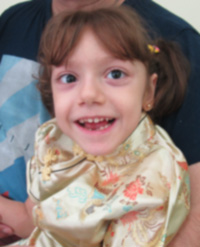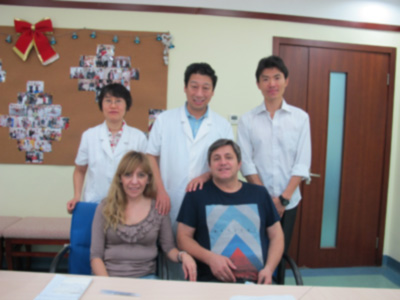Maria - Epilepsy-(Argentina)-Update on Sept. 24th, 2015
Name: Maria Paz Lastra 
Sex: Female
Country: Argentina
Age: 6 years
Diagnoses: Cerebral palsy, Epilepsy, Mild anemia
Admission Date: 2013-08-15
Days Admitted to the Hospital: 32
Before treatment:
She was born during the 30th week of her mother's pregnancy. The weight at birth was 1.2kg. The patient had 3 operations for intestinal obstruction when she was 20 days old. After the operations, the patient suffered from a developmental delay of motor function, speech and visual development. She was diagnosed with cerebral palsy, high myopia of both eyes and astigmatism. She received rehabilitation and visual training every day. The effect was not good. She suffered from epileptic seizure 4 months ago. She had Chickenpox 1 month ago. At present, the patient was unable to turn over, crawl, sit up or walk. Her main diet was milk. The sleep was almost normal. She had urinary incontinence and stool irregularity.
PE:Height: 96cms, weight: 12kgs. Her development was slow. Her nutrition was somewhat poor. The abdomen was even, with many scars from previous operations. There was tympanitic note when tapping the abdomen. There were no masses in her abdomen. The liver and spleen were not palpable under the ribs. The patient was alert. She had a speech disorder and could only sound out the words "grandma" and "Papa". She could not perform the memory, calculation or orientation examinations. Her ability to comprehend was decent. She could communicate with her parents at a fundamental level. Both pupils were equal in size and round. The diameter of the pupils was 3.5mms. Both eyes were flexible to light stimuli. Both eyes had high myopia and astigmatism. The forehead wrinkle pattern was symmetrical. The nasolabial sulcus was equal in depth. She could move her neck to the left and right in supine position. She had trouble supporting her head while in a seated position. Her head would sometimes droop or fade-away. The muscle strength of her waist and back was poor. She could not turn over or maintain a seated position. She was not able to grasp objects with either of her hands. Both lower limbs would move involuntarily. She could not raise her leg off the surface of the bed. The patient's left lower limb is 2 cm shorter than the right lower limb because her left hip joint is dislocated. She could not perform the muscle strength examination of her four limbs. The muscle tone of her four limbs was higher. Adducted to both thumbs and she could not grasp objects. Her abdominal reflexes were weak. The tendon reflex of both upper limbs was normal. The tendon reflex of both lower limbs was active. Bilateral Achilles tendon reflex was not elicited. Bilateral ankle contracture was positive. Bilateral sucking reflex was negative. Bilateral palm jaw reflex was negative. The bilateral Hoffmann sign was negative. Bilateral pathological reflex was positive. She could not perform the sensory examination or the movement coordination examination.
Treatment:
After admission, the patient performed the relevant examinations. She received nerve regeneration treatment and stem cell activating treatment. She was given treatment to improve the blood circulation in order to increase the blood supply to the damaged nerves and nourishment for the neurons. She also received treatment to boost her immunity. This was combined with daily physical rehabilitation therapy.
Post-treatment:
The patient's height: 97.5cm, weight: 12.5Kg. She has a better diet. The patient's language, vision and muscle strength of the limbs is better than before. The patient is better able to independently pronounce words and her language retelling ability has improved. Her ability to pay attention and comprehend has improved. She is better able to move her eyes with ease; her vision is better than before. The visual field is enlarged. She is better able to support her neck, chest and waist. The muscle strength of her four limbs is better than before. At present, the patient can turn over by herself. She can independently maintain a seated position for several minutes. The muscle tone of her four limbs has been reduced, in comparison to before. Both thumbs can abduct and grasp small objects. After treatment, the dislocation of the left hip joint has been alleviated and the length of both lower limbs is equal. The range of hip joint motion is increased.

E-mail:
Date: 2015-9-24
Dear Doctors,
The aim of this e-mail is to communicate Maria Paz's situation after a year of her second treatment with stem cells. I would like to tell you that she is cognitively well. She is attending school and she has been integrated with her classmates with the help of a therapeutic companion. We had a meeting with her teachers and the board of education and they told us that next year she will pass to second grade. She has managed to socialize and has acquired autonomy to decide on various issues. She recognizes numbers and geometric figures and makes sums and subtractions. As well as this, she identifies vowels and consonants and participates not only in regular classes but also in Physical Education classes always on her wheelchair. She also plays with her classmates.
She is still doing rehabilitation and she has shown betterment in her muscle tone. Two months ago, she had a weep operation because she had a dislocation on her left weep side. Doctors made a varizal osteotomia. Due to this, nowadays her left leg is 3 centimeters shorter that the right one. I would like to consult whether she has to keep on taking the medicine you administered her, which ones and the dose. I would also like to know if it will be necessary for her to return to China for another stem cells treatment in the future or if with these two she has gone through it will be enough.
Attached you will find Maria Paz's last tests.
Kind regards,
Gabriela Canales.
